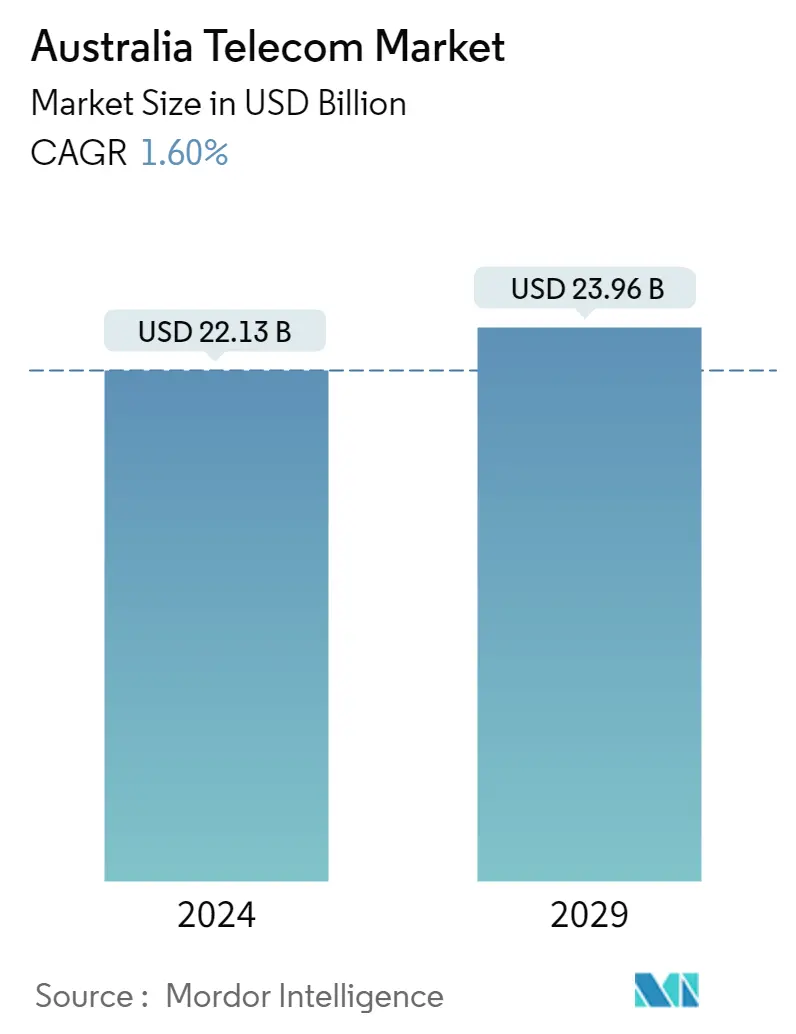Market Size of Australia Telecom Industry

| Study Period | 2019 - 2029 |
| Base Year For Estimation | 2023 |
| Market Size (2024) | USD 22.13 Billion |
| Market Size (2029) | USD 23.96 Billion |
| CAGR (2024 - 2029) | 1.60 % |
| Market Concentration | Low |
Major Players
*Disclaimer: Major Players sorted in no particular order |
Australia Telecom Market Analysis
The Australia Telecom Market size is estimated at USD 22.13 billion in 2024, and is expected to reach USD 23.96 billion by 2029, growing at a CAGR of 1.60% during the forecast period (2024-2029).
The Australian retail market's top three mobile service companies are Telstra, Optus, and TPG. These three mobile service provider companies run significant, vertically integrated telecommunications operations and provide a variety of retail goods for various mobile services.
- Australian telecom companies are maximizing the advantages of a cloud transformation with cloud services like analytics, machine learning, and artificial intelligence (AI) to become data-driven organizations. According to Deloitte estimates, 38% of organizations in Australia are making significant investments in AI. With the widespread use of the cloud in 2020, telecom organizations across the country are benefiting from more control over their data.
- Australian telecom businesses may set the bar high for utilizing the intelligent edge's potential. Australia is among the first nations to implement 5G, and it has a thriving market for technology and system integration providers. The fusion of these technologies may be tested by Australian businesses to further their digital transformation efforts to a greater degree.
- With three active networks, Australia is leading in the deployment of 5G. Australia's mobile network operators (MNOs) had around 4,000 operational 5G base stations installed by the end of 2021, and more were added in 2022. The industry is conducting 5G technology trials with assistance from the Australian government's 5G Innovation Initiative. According to statistics gathered by the GSMA Intelligence, Australia is the third in the world in terms of the number of 5G-connected devices per person.
- Even though the Australian government made clear its commitment to help MNOs install the 5G network quickly and effectively, a lot still rests on MNOs spending money on infrastructure. Even when MNOs purchase more spectrum, the network still needs extra physical infrastructure to support it to provide the coverage and use it can. The Measuring Broadband Australia initiative was extended in 2021 and now covers other market segments, namely NBN fixed. Other superfast access networks offer fixed-line and wireless services.
- As per the Department of Infrastructure, Transport, Regional Development, Communications, and the Arts, an average home will require 420 gigabytes (GB) of monthly data by 2026, which is more than four times the demand in 2016. This prediction is made in the BCAR's Demand for Fixed-Line Broadband in Australia working paper. The development of the National Broadband Network should offer enough broadband capacity for Australian homes, both now and during the decade, despite the country's rapidly increasing data consumption.
- COVID-19 put an unprecedented amount of demand pressure on Australia's communications network. Schools, homes, and many businesses switched to remote working, learning, and socializing almost overnight. All these activities need high-data video communications and web access. According to the Australian competition and consumer commission (ACCC), persistent demand for broadband services and capacity will continue to increase. Technology and communications have enabled Australians to work from home, continue their studies, and stay connected throughout the COVID-19 pandemic. Technological development chances align with the quick development of some key technologies that support Australia's digital economy. By 2022, new telecommunication market opportunities and potential for new company models will be produced by Australia's economic and technical changes.
Australia Telecom Industry Segmentation
The study provides an in-depth analysis of the telecommunication industry in Australia. The Australian telecom market is segmented by services, which is further classified into voice services (wired, wireless), data and messaging services, and OTT and pay TV.
| Segmentation by Services (Coverage to include Average Revenue Per User for the overall Services segment, Market size and Estimates for each segment for the period of 2020-2027 and in-depth Trend Analysis) | ||||
| ||||
| Data and Messaging Services (Coverage to include Internet & Handset Data packages, Package Discounts) | ||||
| OTT and Pay-tv Services |
Australia Telecom Market Size Summary
The Australian telecom market is characterized by a competitive landscape with major players such as Telstra, Optus, and TPG Telecom leading the sector. These companies operate extensive, vertically integrated telecommunications networks, offering a wide range of mobile services and retail goods. The market is witnessing a significant transformation driven by the adoption of advanced technologies like cloud services, artificial intelligence, and machine learning, which are helping telecom companies become more data-driven. The deployment of 5G technology is a key focus, with Australia being a frontrunner in 5G implementation, supported by government initiatives and a robust infrastructure. This technological advancement is expected to enhance productivity across various sectors, including healthcare, finance, and manufacturing, by providing faster internet speeds and enabling applications that require low latency and high connectivity.
The Internet of Things (IoT) is emerging as a significant revenue stream within the Australian telecom industry, with companies like Telstra, Optus, and TPG Telecom investing in IoT technologies to expand their service offerings. The market is highly fragmented, with numerous players including ISPs, MVNOs, and fixed-line service providers, contributing to a dynamic competitive environment. Innovations such as TPG Telecom's G.Fast technology for fast broadband services and Aussie Broadband's partner program for resellers are examples of how companies are striving to enhance their market presence and service capabilities. The ongoing digital transformation, accelerated by the COVID-19 pandemic, has increased demand for broadband services, prompting telecom companies to invest in infrastructure and technology to meet the growing data consumption needs of Australian households and businesses.
Australia Telecom Market Size - Table of Contents
-
1. MARKET INSIGHTS
-
1.1 Market Overview
-
1.2 Industry Ecosystem Analysis
-
1.3 Industry Attractiveness-Porter's Five Force Analysis
-
1.3.1 Bargaining Power of Suppliers
-
1.3.2 Bargaining Power of Consumers
-
1.3.3 Threat of New Entrants
-
1.3.4 Threat of Substitute Products
-
1.3.5 Intensity of Competitive Rivalry
-
-
1.4 Impact of COVID-19 on the Industry Ecosystem
-
1.5 Regulatory Landscape in the Country
-
-
2. MARKET SEGMENTATION
-
2.1 Segmentation by Services (Coverage to include Average Revenue Per User for the overall Services segment, Market size and Estimates for each segment for the period of 2020-2027 and in-depth Trend Analysis)
-
2.1.1 Voice Services
-
2.1.1.1 Wired
-
2.1.1.2 Wireless
-
-
2.1.2 Data and Messaging Services (Coverage to include Internet & Handset Data packages, Package Discounts)
-
2.1.3 OTT and Pay-tv Services
-
-
Australia Telecom Market Size FAQs
How big is the Australia Telecom Market?
The Australia Telecom Market size is expected to reach USD 22.13 billion in 2024 and grow at a CAGR of 1.60% to reach USD 23.96 billion by 2029.
What is the current Australia Telecom Market size?
In 2024, the Australia Telecom Market size is expected to reach USD 22.13 billion.

